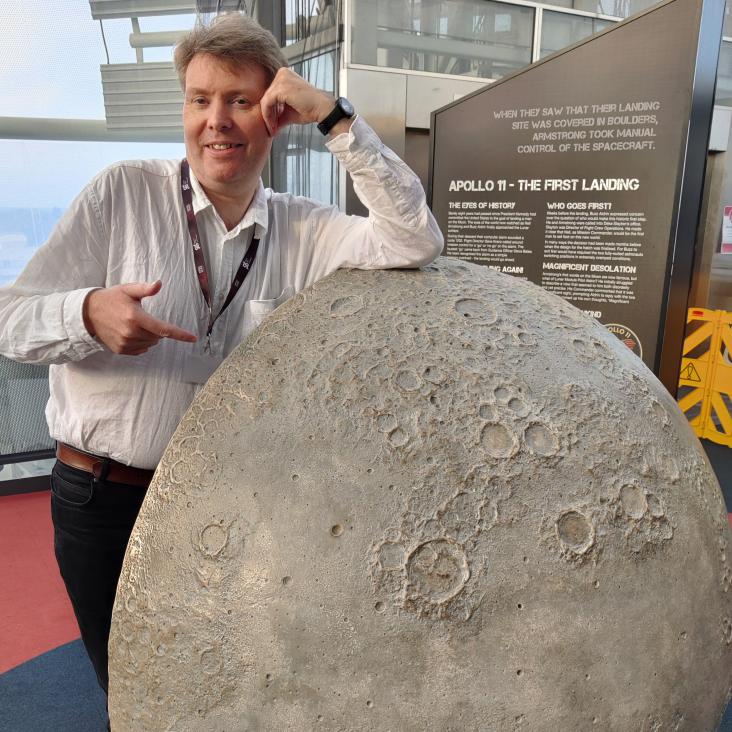A new experimental setup for making thermal emission measurements in a simulated lunar environment.
Rev Sci Instrum 83:12 (2012) 124502
Abstract:
One of the key problems in determining lunar surface composition for thermal-infrared measurements is the lack of comparable laboratory-measured spectra. As the surface is typically composed of fine-grained particulates, the lunar environment induces a thermal gradient within the near sub-surface, altering the emission spectra: this environment must therefore be simulated in the laboratory, considerably increasing the complexity of the measurement. Previous measurements have created this thermal gradient by either heating the cup in which the sample sits or by illuminating the sample using a solar-like source. This is the first setup able to measure in both configurations, allowing direct comparisons to be made between the two. Also, measurements across a wider spectral range and at a much higher spectral resolution can be acquired using this new setup. These are required to support new measurements made by the Diviner Lunar Radiometer, the first multi-spectral thermal-infrared instrument to orbit the Moon. Results from the two different heating methods are presented, with measurements of a fine-grained quartz sample compared to previous similar measurements, plus measurements of a common lunar highland material, anorthite. The results show that quartz gives the same results for both methods of heating, as predicted by previous studies, though the anorthite spectra are different. The new calibration pipeline required to convert the raw data into emissivity spectra is described also.An integrated payload design for the Exoplanet Characterisation Observatory (EChO)
Proceedings of SPIE--the International Society for Optical Engineering SPIE, the international society for optics and photonics 8442 (2012) 84421g-84421g-14
Investigation of new band parameters with temperature dependence for self-broadened methane gas in the range 9000 to 14,000cm -1 (0.71 to 1.1μm)
Journal of Quantitative Spectroscopy and Radiative Transfer 113:10 (2012) 763-782
Abstract:
This paper describes new measurements and modelling of the absorption of methane gas, one of the most important gases observed in the atmospheres of the outer planets and Titan, between 9000 and 14,000cm -1 (0.7 to 1.1μm) and compares them with current best available spectral models.A series of methane spectra were measured at the UK's Natural Environment Research Council (NERC) Molecular Spectroscopy Facility (based at the Rutherford Appleton Laboratory, Oxfordshire, UK) using a Brüker 125HR Fourier transform spectrometer. To approximate the conditions found in outer planet atmospheres, the spectra were measured over a wide range of pressures (5bar to 38mbar) and temperatures (290-100K) with path lengths of 19.3, 17.6, 16.0 and 14.4m. The spectra were recorded at a moderate resolution of 0.12cm -1 and then averaged to 10cm -1 resolution prior to fitting a series of increasingly complex band-models including temperature dependence. Using the most complex model, a Goody line distribution with a Voigt line shape and two lower energy state levels, the typical rms residual error in the fit is between 0.01 and 0.02 in the wings of the main absorption bands.The new spectral parameters were then compared with the measured spectra and spectra calculated using existing data and shown to be able to accurately reproduce the measured absorption. The improvement in the temperature dependence included in the model is demonstrated by comparison with existing cold methane spectral data for a typical Jovian path. © 2012 Elsevier Ltd.EnVision: taking the pulse of our twin planet
Experimental Astronomy Springer Nature 33:2-3 (2012) 337-363
Lunar Net—a proposal in response to an ESA M3 call in 2010 for a medium sized mission
Experimental Astronomy Springer Nature 33:2-3 (2012) 587-644


